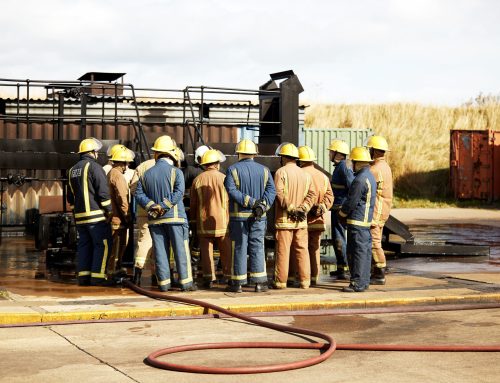Introduction
Workplace safety training is one of the most important things you can do to protect your workers. Whether you manage an office, a warehouse, a hospital, or a construction company, safety training teaches people how to avoid accidents, handle emergencies, and use equipment properly.
But safety training isn’t something you can just do once and forget about. It needs to be updated regularly. Why? Because your workplace isn’t standing still. Processes change, rules change, equipment changes; and when those things change, your safety training needs to change, too.
Keeping your safety training up to date isn’t just about following the rules. It’s about making sure everyone goes home safe at the end of the day—and that your company stays in compliance with federal, state, and industry regulations.
Every industry has general guidelines that companies must implement on a regular basis, and in this post, you’ll learn why safety training updates are important, how often to do them, and how to know when it’s time to make a change.

Why Updating Safety Training Matters
When your training isn’t current, your workers are at risk, and your company is more likely to face safety violations, injuries, and even legal trouble. Workplaces change constantly, and new hazards can show up anytime. For example, a new piece of machinery or a new chemical might require specific training that your current materials don’t cover. Without an update, workers may not be prepared to use new tools or handle unfamiliar risks.
Regulations change, too. The Occupational Safety and Health Administration (OSHA)—and other regulatory agencies—often update safety standards when new information is discovered regarding workplace hazards or equipment. If your training doesn’t reflect the most recent rules, your company may be out of compliance. Worse, it may mean that workers aren’t protected against the most current known hazards.
Even without changes to your workplace or the rules, people can forget what they’ve learned and slip into unsafe habits over time. When you refresh training regularly, you give employees a chance to reset and remind them of the right way to do things.
When training is outdated, it can lead to accidents and injuries. In extreme cases, it may even lead to a fatality if employees working with dangerous hazards do not know the proper procedures. If something goes wrong and investigators find that your training was old or incomplete, the company could be held responsible and face legal action.

General Guidelines for Training Frequency
Unfortunately, there is no universal schedule for when safety training needs to be updated. Some should be refreshed every year, while others might only need updates when something changes. Here’s a general breakdown of when you should review and update training materials:
● Annually: Topics like fire safety, emergency procedures, and personal protective equipment (PPE) should be covered at least once a year. Even if the procedures haven’t changed, people benefit from regular reminders. Some topics, like ergonomics or hazard awareness in low-risk environments, can be reviewed less frequently, depending on your workplace needs, but annual training, even when not required for a specific topic, is a common best practice.
● After Incidents or Near-Misses: If someone gets hurt or nearly injured, update your training to address the cause and prevent it from happening again. Training that has been updated to address a specific incident should be taken by any employees who work with the hazard or equipment that was the cause of the incident.
● When Job Roles, Tools, or Procedures Change: Any time your team starts doing something new—such as operating a new machine, working with new materials, or changing how tasks are performed—you need to train them on the new process.
● When Regulations Change: If OSHA or another safety authority updates a rule, your training needs to match the new requirements.
While not required for all training, an annual revisit of safety procedures is a common best practice. Remember: Training more frequently than necessary is better than not enough. When it comes to taking care of your people, you’d rather be safe than sorry.

OSHA and Regulatory Requirements
OSHA doesn’t always say exactly how often training must be updated. In many cases, the rule is that training must be “effective.” That means it has to work—it must prepare workers to do their jobs safely. If employees are confused, making mistakes, or following unsafe practices, the training isn’t considered effective, even if it’s recent.
Despite this general rule, there are some topics where OSHA sets specific rules about how often training must happen. For example:
● Hazard Communication (HazCom) must be updated when new chemical hazards are introduced.
● Forklift operators must be evaluated every three years or sooner if they’re involved in an incident or observed operating unsafely.
● Bloodborne pathogens training must be repeated annually.
● Respiratory protection training and fit testing must also happen every year for anyone who wears a respirator. Similar standards can be found online at osha.gov.
Though not required, OSHA does have recommendations for the evaluations and improvement of safety training programs, and those can be found here.
In addition to OSHA’s rules, your state or industry might have its own safety standards. Always check local and industry-specific guidelines to make sure your training is up to date. Staying informed helps you avoid violations and gives your team the most accurate information possible.
Best Practices for Keeping Training Up to Date
If you want to stay ahead of training needs, there are a few best practices you should follow. First, maintain a training schedule. A simple spreadsheet or training management system can help you track when employees completed training and when they’re due for another round. This prevents you from missing important deadlines. Many Learning Management Systems (LMS) have these in place automatically, so you don’t have to worry about keeping track of it yourself.
Next, review your training content at least once a year. Even if no major changes have occurred, it’s worth checking to make sure your materials are still accurate and easy to understand. If your procedures or safety rules have changed, update the training immediately.
Don’t forget to involve employees in the process. Ask them if the training is clear, useful, and relevant. Your workers are the ones using the training every day, and their feedback can help you improve your program.
You can also reinforce training with simple tools like refresher quizzes and toolbox talks. A five-minute safety talk before a shift or a short quiz at the end of a training session can help solidify what people have learned.
Finally, make sure someone is responsible for tracking rule changes. Whether it’s a safety manager or a supervisor, someone should be in charge of keeping the company updated on OSHA updates, new technologies, and industry best practices. This helps you respond quickly when changes happen.

Signs Your Training Needs an Update
Not sure if your safety training is due for a refresh? Watch for these warning signs:
● Employees are unsure about procedures or frequently ask for clarification.
● Workers are making the same safety mistakes again and again.
● There has been a recent incident, injury, or near-miss.
● New tools, chemicals, machines, or job duties have been added to the workplace.
● Your training materials refer to outdated standards, old equipment, or rules that have been changed.
These signs often show up before accidents happen. If you catch them early, you have the chance to improve your safety training and prevent injuries. Don’t ignore red flags—act quickly when you notice them.

Conclusion
Safety training isn’t something you can do once and forget about; it should be an ongoing process. Processes change, hazards evolve, people forget what they’ve learned, and that’s why it’s so important to keep your training materials up to date.
While we have covered some of the enforced regulations regarding how often training should be updated and when employees should retake training, we cannot cover all standards here. It is the responsibility of every company to become familiar with the necessary training frequency of the required safety training in their industry and to create a training schedule that complies with industry regulations.
When you review and refresh training regularly, you help protect your team and keep your company in line with safety regulations. Look at your current training program. What needs attention? Which courses haven’t been reviewed in a while? Are workers confident in what they know?
Don’t wait until after an accident to update your training. Be proactive: set a schedule, track your progress, and make safety training a regular part of your workplace culture.
Safety Instruct’s online safety training courses help to educate employees on workplace safety and health regulations, policies, and best practices. These courses cover a wide range of topics, all designed to fit the needs of various industries. Additionally, Safety Instruct’s Learning Management System, Capability, automatically tracks employee compliance and sends out alerts when refresher training needs to be taken. To find the courses you need for your business today, click the link below! https://www.safetyinstruct.com/










Leave A Comment